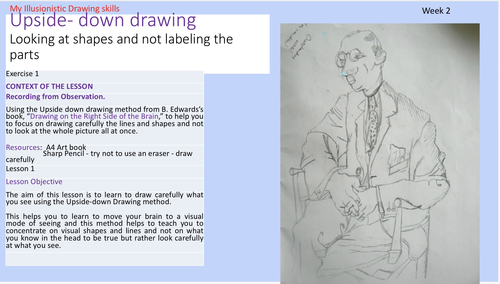




This tasks help to assess abilities and specific skills in Art. This helps to establish a Baseline Assessment for Art after having completed all these exercises. This should take 10-12 lessons. Please work through each exercise carefully.
The aim of this diagnostic assessment is to look at specific skills used in art.
This diagnostic study is to try to assess different skills in Art. The tasks given are for the different learning/skills in art and it allows the pupils to explore these. There are tasks given for each area of learning.
Areas of learning with task:
ILLUSIONISTIC learner: draw illusionistically, blind drawing and upside down drawing exercises.
CARTOGRAPHIC learner: draw a personal logo (black and white pattern)(use on art books as a name tag).
TACTILE learner: Looking at Van Gogh, Gustav Klimt, Chris Ofili and Hundertwasser’ portrait works, their use of lines, shapes, colours and textures. Pupils will choose one of these artists to develop in a tactile way using re-cycled materials.
SPATIAL learner: drawing with wire and string, assess whether good at sculptural form.
Furthermore, assess the students ability to write ANALYTICALLY and to critically analyse a painting… The pupils will also need to self assess and evaluate their outcomes.
At the end of this exercise we would be able to assess pupils strengths and weaknesses in art at KS 3 and there are many opportunities in the presentation for evaluation.
-
How to create an illusionistic space and to draw from first hand observation using blind drawing skills, contour line drawing, upside-down drawing and mark-making.
-
Focus on how to shade using dark and light tones with pencil and biro pens and focus on mark-making.
3 a To critically analyse other artist’s styles and techniques and select and question critically, making reasoned choices when developing work from observation.
3 b. Explore tactile qualities and select a range of materials to interpret a style of an artist. Develop a portrait using tactile materials.
-
Investigate how to express ideas using design skills and design processes and the formal elements like line, colour and flat shapes with patterns
-
Exploring drawing with a 3D structure and looking at shape and line with construction of wire developing spatial recognition.
-
Analysing an artwork and investigating the formal elements used in an artwork.
-
Reflect on and evaluate one’s own and others’ work, adapting and refining the outcomes.
Presentation should also be assessed at the end of these exercises. Students should also always write a heading and the lesson objective clearly at the top of each page. There are clear evaluation sheets and assessment opportunities in the unit of work.
All tasks are presented with Lesson Objective and clear practical tasks.
Get this resource as part of a bundle and save up to 47%
A bundle is a package of resources grouped together to teach a particular topic, or a series of lessons, in one place.
Drawing skills - techniques and skills for Key stage 3
These are important skills for Key Stage 3 There powerpoints aim to develop the following skills below and in so doing develop confidence in drawing Line exercises with blind, contour, gestural drawing skills Upside down drawing -how to copy Sphere drawing - teaching tonal drawing Drawing to create an impact with pattern and different techniques - feather drawing Portrait drawing - looking at proportions in a face drawing Fun- confident line combining a photo in drawing
Introduction to Art in Year 7
This is a unit of work for the first 12 weeks at school. There are questions to assess the students knowledge of Art from KS2 and then a project to assess he strengths and skills of the students. This is a diagnostic project looking at the Illusionary, Spatial, Tactile, Cartographic skills of the students with tasks to do. There is also a fun project on making a sketchbook and giving prompts to help students to be creative in the Keri Smith powerpoint.
Something went wrong, please try again later.
This resource hasn't been reviewed yet
To ensure quality for our reviews, only customers who have purchased this resource can review it
Report this resourceto let us know if it violates our terms and conditions.
Our customer service team will review your report and will be in touch.